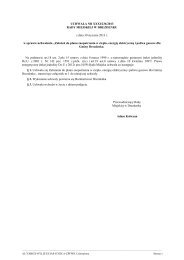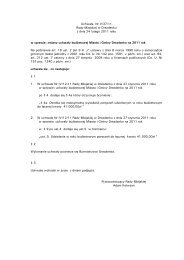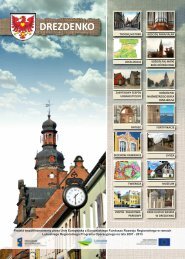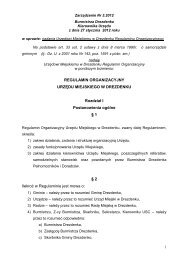Folder o elementach zabytkowych w Gminie Drezdenko wydany w ...
Folder o elementach zabytkowych w Gminie Drezdenko wydany w ...
Folder o elementach zabytkowych w Gminie Drezdenko wydany w ...
Erfolgreiche ePaper selbst erstellen
Machen Sie aus Ihren PDF Publikationen ein blätterbares Flipbook mit unserer einzigartigen Google optimierten e-Paper Software.
Gmina <strong>Drezdenko</strong><br />
Projekt współfinansowany przez Unię Europejską z Europejskiego Funduszu Rozwoju Regionalnego w ramach<br />
Lubuskiego Regionalnego Programu Operacyjnego na lata 2007 - 2013
BAZA NOCLEGOWA<br />
Hotele<br />
1. Hotel Eljan<br />
ul. Ogrodowa 4, 66-530 <strong>Drezdenko</strong><br />
tel. 95 762 94 71<br />
kom. 606 766 380<br />
www.hoteleljan.com.pl<br />
hoteleljan@hoteleljan.com.pl<br />
Pensjonaty<br />
1. Gościniec "Wilcze Doły"<br />
Kazimierz Dębski, Zielątkowo 40<br />
tel. 95 762 42 91<br />
kom. 697 227 151<br />
www.regres.pl/wilczedoly.htm<br />
wilczedoly@op.pl<br />
60 miejsc noclegowych, pok. 2 osobowe i apartamenty,<br />
stołówka, pole namiotowe, boisko do gier, korty ziemne, możliwość<br />
wypozyczenia rowerów górskich<br />
2. "U Jana"<br />
nad jez. Solecko w Gościmiu<br />
tel. 95 762 04 97<br />
3. “Karczma Lubiatka”<br />
Zdzisław Wiśniewski, Lubiatów 20, 66-530 <strong>Drezdenko</strong><br />
tel. 95 762 44 91<br />
kom. 602 312 087<br />
turystyka@akme.pl<br />
pokoje 1, 2 i 3 osobowe, 2 domki wolnostojące, altana grilowa<br />
60 miejsc noclegowych<br />
Ośrodki<br />
1. Ośrodek Turystyki i Rekreacji Jeździeckiej w Kosinie<br />
koło Drezdenka<br />
"WARSDOM" Sp. z o.o., Kosin 26, 66-530 <strong>Drezdenko</strong><br />
tel. 95 762 54 14/15<br />
fax 95 727 64 90<br />
www.konie-kosin.pl<br />
stadnina@konie-kosin.pl<br />
ok 160 miejsc noclegowych, nauka jazdy konnej, przejażdzki<br />
bryczkami<br />
2. Ośrodek Wypoczynkowy "MERPOL" sp. z o.o.<br />
Lubiewo 1, 66-530 <strong>Drezdenko</strong><br />
tel. 95 762 05 47<br />
40 miejsc noclegowych<br />
3. O.W "ZACISZE" T.H. SŁABY s.c<br />
Goszczanowo 68 a, 66-530 <strong>Drezdenko</strong><br />
tel. 95 762 42 13<br />
fax 95 762 42 12<br />
kom. 507 928 126, 693 720 582<br />
www.ow-zacisze.pl<br />
biuro@ow-zacisze.pl<br />
osrodek-gozdrew@trol.pl<br />
posiadamy 140 miejsc noclegowych w 1,2,3 i 4 osobowych oraz<br />
rowery górskie<br />
4. Ośrodek Wczasowy w Zagórzu<br />
tel. 95 762 05 85, 22 551 45 75<br />
sezon od 01.07. do 30.08.<br />
5. Ośrodek Wypoczynkowy " Za Lasem"<br />
Gościm 97a, 66-535 Gościm<br />
tel. 95 762 42 84<br />
kom. 501 223 223<br />
turystyka@akme.pl<br />
27 pokoi , 116 miejsc noclegowych, boisko do gier, plac zabaw dla<br />
dzieci, kort tenisowy i siłownię, apartamenty, pole namiotowe i<br />
kampingi, wypożyczalnia sprzętu pływającego<br />
6. Spółdzielnia Inwalidów<br />
Ośrodek Rehabilitacyjno - Wypoczynkowy im. prof. Wiktora Delegi,<br />
Gościm 89<br />
tel. 95 762 42 38, 95 762 42 92<br />
fax 95 762 42 39<br />
www.rehabilitacja.ta.pl<br />
rehabilitacja@ta.pl<br />
orwgoscim@o2.pl<br />
biuro@sireh.zphr.pl<br />
pokoje hotelowe i letniskowe, konsumpcja, odnowa biologiczna,<br />
kompleks boisk, siłownia, basen, sauna, solarium, kort tenioswy,<br />
kręgielnia, bilard, rowery terenowe i wodne, kajaki, tenis stołowy,<br />
pole namiotowe i kempingowe<br />
Agroturystyka<br />
1. Villa Drawa<br />
Przeborowo 33, 66-530 <strong>Drezdenko</strong><br />
tel./fax 95 762 41 23<br />
kom. 604 250 960<br />
villadrawa@wp.pl<br />
pokoje z łazienkami TV/SAT, domowe jedzenie, konie,bryczki,<br />
wycieczki rowerowe i piesze, spływy kajakowe Drawą<br />
2. Marek Paś<br />
Przeborowo 30, 66-530 <strong>Drezdenko</strong><br />
tel. 95 762 56 05<br />
kom. 602 833 327<br />
spływy kajakowe, pokoje 4 osobowe, 11 miejsc noclegowych<br />
3. Agroturystyka<br />
Włodzimierz Kujawski, Przeborowo 23<br />
tel. 95 762 56 04<br />
kom. 505 053 490<br />
www.naddrawa.prv.pl<br />
grzybobranie, wędkowanie, jazda konna, spływy Drawą<br />
4. Agroturystyka<br />
Jadwiga Górska, Przeborowo 25a<br />
tel. 95 762 16 71<br />
kom. 600 809 127<br />
www.drawaclub.prv.pl<br />
nauka jazdy konnej, spływy kajakowe Drawą, 4 pokoje,<br />
14 miejsc noclegowych<br />
5. AGROTURLOT<br />
Trzebicz Nowy 55, 66-530 <strong>Drezdenko</strong><br />
tel. 95 762 08 74, 95 762 48 45<br />
www.agroturlot.pl<br />
6 pokoi 2 osobowych, kuchnia, telewizor, internet, jazda konna,<br />
basen, bilard, siłownia, wycieczki rowerowe i piesze<br />
6. “STAJNIA NAD DRAWĄ”<br />
Drawiny 55, 66-530 <strong>Drezdenko</strong><br />
tel. 95 762 41 22, 67 253 64 37<br />
kom. 600 154 746<br />
www.agroturystyka.drawiny.pl<br />
3 dwuosobowe pokoje, łazienka, boisko do siatkówki,<br />
domowe jedzenie, jazda konna
Gmina <strong>Drezdenko</strong><br />
Według obowiązującego od 1 stycznia 1999r.<br />
podziału administracyjnego, <strong>Drezdenko</strong><br />
stanowi część powiatu strzelecko – drezdeneckiego<br />
i należy do województwa<br />
lubuskiego. Położone jest nad Notecią. Obszar<br />
gminy <strong>Drezdenko</strong> (około 400 km²,<br />
z czego 75% to lasy) zajmuje centralną część<br />
Kotliny Gorzowskiej rozciągając się od skraju<br />
Puszczy Drawskiej do granic Puszczy Noteckiej.<br />
Żyje tutaj prawie 18 tysięcy mieszkańców,<br />
z tego w samym Drezdenku niemal 11<br />
tysięcy.<br />
Gemeinde <strong>Drezdenko</strong> (Driesen)<br />
Gemäß der heutigen, ab dem 1. Januar 1999<br />
geltenden administrativen Gliederung, bildet<br />
<strong>Drezdenko</strong> einen Teil des Kreises Strzelce-<br />
<strong>Drezdenko</strong> und gehört zur Woiwodschaft<br />
Lebus. Die Stadt liegt am Fluss Noteć (Netze).<br />
Das Gebiet der Gemeinde <strong>Drezdenko</strong> (ca.<br />
400 km2, darunter 75% Waldgebiete) nimmt<br />
den zentralen Teil des Talkessels Kotlina Gorzowska<br />
(Landsberger Talkessel) ein, das sich<br />
vom Rand der Puszcza Drawska (Drage-Urwald)<br />
bis zu den Grenzen der Puszcza<br />
Notecka (Netze-Urwald) erstreckt. Es leben<br />
hier fast 18.000 Einwohner, darunter fast<br />
11.000 in der Stadt <strong>Drezdenko</strong>.<br />
<strong>Drezdenko</strong> borough<br />
According to the present administrative division<br />
that has been in force since January<br />
1, 1999, <strong>Drezdenko</strong> is part of Strzelce-<strong>Drezdenko</strong><br />
county and Lubusz Voivodeship. The<br />
town is located by the Noteć River. The area<br />
of <strong>Drezdenko</strong> borough (approx. 400 km2,<br />
75% of it woodland) takes up the central part<br />
of Gorzowska Valley and extends across the<br />
Noteć River Glacial Valley from the edge of<br />
Drawa Virgin Forest to the border of Noteć<br />
Virgin Forest. The area is populated by 18<br />
thousands inhabitants; almost 11 thousand<br />
of them live in <strong>Drezdenko</strong>.<br />
2
Do najważniejszych zabytków gminy należą:<br />
Do najważniejszych zabytków gminy należą:<br />
Dawna prochownia z XVII w. przebudowana na<br />
spichlerz, obecna siedziba Muzeum Puszczy Drawskiej<br />
i Noteckiej im. Franciszka Grasia. Budynek muzeum<br />
zbudowano na początku XVII wieku z przeznaczeniem,<br />
w związku z budową (1603 - 1605) twierdzy typu nizinnego,<br />
na prochownię. Po likwidacji twierdzy (1765 rok)<br />
przeznaczono obiekt na magazyn produktów<br />
żywnościowych. Magazynowano w obiekcie m.in.<br />
zboże (stąd spichlerz).<br />
Zu den wichtigsten Shenswürdigkeiten in der<br />
Gemeinde gehören:<br />
Das ehemalige Pulvermagazin aus dem 17. Jahrhundert,<br />
in den Speicher umgebaut, heute Sitz des Franciszek<br />
Graś Drawska- und Noteć- Urwaldmuseums.<br />
Das Gebäude des heutigen Museums wurde Anfang<br />
des 17. Jahrhunderts errichtet und für das Pulvermagazin<br />
bestimmt, was mit dem Aufbau (1603-1605)<br />
einer Flachlandfestung verbunden war. Nachdem die<br />
Festung abgebaut worden war (1765), wurde das<br />
Bauwerk zum Nahrungsmittellager umgewandelt. Es<br />
wurde hier unter anderen Getreide gelagert (deshalb<br />
der Name Speicher).<br />
The town’s most import historic buildings include:<br />
Former powder magazinefrom the 17th century converted<br />
into Granary, today seat of Franciszek Graś<br />
Drawa and Noteć Virgin Forest Museum. The museum<br />
building was erected in the early 17th century<br />
and designed for a powder magazine in connection<br />
with construction (1603-1605) of the lowland fortress.<br />
After liquidation of the fortress (1765), is was transformed<br />
into food storehouse. Among other products,<br />
grain was stored there (this is why it is called Granary).<br />
3
Zespół Pałacowo – Parkowy przy Placu Wolności<br />
z późnobarokowym pałacem z 1766 roku, obecnie<br />
siedziba Gimnazjum nr 1. Cały kompleks budynków<br />
Gimnazjum nr 1 jest położony<br />
w obrębie twierdzy wybudowanej przez Brandenburczyków<br />
w początku XVII wieku, po której<br />
pozostały części fosy, resztki bastionów ( “górki za<br />
boiskiem”), fundamenty pod pałacem, prochownia<br />
i budynek bramny.<br />
Schloss- und Parkanlage am Plac Wolności (Platz<br />
der Freiheit) mit spätbarockem Schloss aus dem<br />
Jahr 1766, heute Sitz des Gymnasiums Nr. 1. Der<br />
ganze Komplex der Schulgebäude steht auf dem<br />
Gelände der von den Brandenburgern am Anfang<br />
des 17. Jahrhunderts errichteten Festung, von der<br />
heute unter anderem Teile des Festungsgrabens,<br />
Überreste der Bastionen (Hügel auf dem Fußballspielplatz),<br />
Fundamente unter dem Schloss, das<br />
Pulvermagazin und das Torhaus erhalten<br />
geblieben sind.<br />
Zespół Pałacowo – Parkowy<br />
Manor and Park Complex at Plac Wolności<br />
square, late-baroque manor from 1766, today<br />
seat of Junior High School No. 1. The whole complex<br />
of school buildings is situated on the area of<br />
a fortress that was erected by Brandenburgians at<br />
the turn of the 17th century, from that parts of<br />
moat, remainders of bastions (“hills” on the football<br />
playground), foundations under the manor,<br />
powder magazine and gatehouse remained.<br />
4
Kościół Parafialny p.w. Przemienienia Pańskiego<br />
wybudowano w latach 1898 - 1902 według projektu<br />
architekta prof. Johannesa Otzena (choć są tacy,<br />
którzy autorstwo projektu przypisują architektowi<br />
o nazwisku Spitt). Służył on ewangelitom do 1945 r.<br />
5 sierpnia 1945 r. został poświęcony przez pierwszego<br />
proboszcza ks. mgr Teofila Widełka CRL do obrządku<br />
rzymsko - katolickiego. Kościół wybudowano w stylu<br />
neogotyckim, a okna wyposażono w witraże dwustronne<br />
patynowe. W oknach prezbiterium przedstawiono<br />
sceny z Nowego Testamentu oraz bogato<br />
zdobione motywy roślinne. Kościół wyposażony jest<br />
w organy wykonane przez firmę Sauera z Frankfurtu<br />
nad Odrą. W latach 1920 - 1921 na wieży kościoła<br />
umieszczono wykonane w Bochum trzy dzwony staliwne,<br />
które służą do dziś.<br />
5Kościół Parafialny p.w. Przemienienia Pańskiego<br />
Pfarrkirche der Verklärung Christi wurde in Jahren<br />
1898 – 1902 nach dem Entwurf des Architekten Prof.<br />
Johannes Otzen errichtet (obwohl es auch Forscher<br />
gibt, die die Autorschaft des Entwurfs dem Architekten<br />
namens Spitt zuschreiben). Bis 1945 war sie eine<br />
evangelische Kirche und am 5. August 1945 wurde<br />
sie von dem ersten polnischen Pfarrer, Teodor<br />
Widełek CRL, als römisch-katholisches Gotteshaus<br />
geweiht. Die Kirche wurde in neugotischen Stil erbaut<br />
und die Fenster mit doppelseitigen farbigen patinierten<br />
Glasmalereien geschmückt. In den Fenstern<br />
im Altarraum sind Szenen aus dem Alten Testament<br />
und reich geschmückte Blumenmotive dargestellt.<br />
Die Kirche ist mit einer von der Firma Sauer aus<br />
Frankfurt/Oder erbauten Orgel ausgestattet. In den<br />
Jahren 1920 – 1921 wurden im Kirchturm drei in<br />
Bochum gegossene Stahlgussglocken aufgehängt, die<br />
bis heute der kirchlichen Gemeinde dienen.<br />
Parish Church of the Transfiguration of Jesus was<br />
erected between 1898 and 1902 in accordance with<br />
the design of professor Johannes Otzen (although<br />
some scientists ascribe the design authorship to an<br />
architect named Spitt). Until 1945 it was an Evangelical<br />
temple. On August 5, 1945, it was consecrated by<br />
the first Polish rector, Rev. Teofil Widełek CRL as a<br />
Roman-Catholic church. The church was built in neo-<br />
Gothic style and the windows were equipped with<br />
double-sided, patina stained-glass panels. In the<br />
stained-glass windows of the chancel there are<br />
scenes from the New Testament and richly adorned<br />
flowery motifs. The church is equipped with an organ<br />
built by Sauer company from Frankfurt/Oder. In the<br />
years 1920 - 1921 in the church tower three manufactured<br />
in Bochum cast steel bells were placed; since<br />
then they still have been used.
Zespół kamieniczek zdobionych secesyjnymi ornamentami.<br />
W Drezdenku można spotkać wiele ciekawych reliktów<br />
architektury, w tym głównie secesyjnych. Większość tych<br />
budowli znajduje się w śródmieściu, głównie przy takich<br />
ulicach jak: Wiejska, Kościuszki, Stary Rynek, Łąkowa,<br />
Krakowska, Poniatowskiego, Warszawska. Wiele różnorodnych<br />
detali wykonanych w metalu, drewnie czy też<br />
szkle, zdobi w różnych miejscach naszego miasta bramy,<br />
balkony, poręcze czy też schody, tworząc niepowtarzalny<br />
charakter ozdób z tego okresu. Średniowieczny układ urbanistyczny<br />
- zabudowa XVIII - XIX w., wiodący styl architektoniczny:<br />
secesja, ciekawy układ ulic, dwa<br />
równolegle położone rynki.<br />
Ensemble der mit Jugendstilornamenten verzierten<br />
Bürgerhäuser<br />
In <strong>Drezdenko</strong> sind viele interessante Relikte der sogenannten<br />
„kleinen Architektur“, größtenteils im Jugendstil, zu<br />
finden. Die meisten derartigen Gebäude befinden sich<br />
im Stadtzentrum, vor allem in solchen Straßen wie:<br />
Wiejska, Kościuszki, Stary Rynek, Łąkowa, Krakowska,<br />
Poniatowskiego, Warszawska. In verschiedenen Teilen<br />
unserer Stadt werden Tore, Balkons, Geländer oder Treppen<br />
mit zahlreichen Details verschiedener Art<br />
geschmückt. Sie sind aus Metall, Holz oder Glas gefertigt<br />
und zeugen von dem einmaligen Charakter der<br />
Verzierungen aus dieser Periode. Mittelalterliche städtebauliche<br />
Gliederung, Bebauung aus dem 18.-19. Jh., vorwiegender<br />
architektonischer Stil: Jugendstil,<br />
interessantes Straßensystem, zwei parallel gelegene<br />
Marktplätze.<br />
Historic complex of buildings decorated with Art Nouveau<br />
ornaments<br />
In <strong>Drezdenko</strong> you can find many interesting relics of so<br />
called “small architecture”, mostly in Art Nouveau style.<br />
Those structures are situated mostly in the town’s centre,<br />
first of all in the following streets: Wiejska, Kościuszki,<br />
Stary Rynek, Łąkowa, Krakowska, Poniatowskiego,<br />
Warszawska. Many various details made from metal,<br />
wood or glass embellish entrance gates, balconies,<br />
handrails or stairs in different places of our town, being<br />
an evidence of the unique character of architectonic<br />
adornments in that period. Medieval urban arrangement,<br />
buildings from the 18th and 19th centuries, predominant<br />
architectonic style: Art Nouveau, an interesting<br />
arrangement of streets, two parallel situated market<br />
squares.<br />
Zespół kamieniczek zdobionych secesyjnymi ornamentami<br />
6
Kościół p.w. Podwyższenia Krzyża Świętego - uprzednio<br />
p.w. Ducha Świętego. Jest to konstrukcja ryglowa<br />
wzniesiona w 1778 roku. Posiada<br />
jednonawowe wnętrze barokowe z drewnianym,<br />
bogato zdobionym sufitem. Kościół wyświęcony<br />
w 1952 roku.<br />
Kreuzerhöhungskirche – früher Heiliggeistkirche.<br />
Es ist ein Fachwerkbauwerk, errichtet im Fahr 1778.<br />
Es besitzt einen einschiffigen barocken Innenraum<br />
mit reich verzierter Holzdecke. Die Kirche wurde<br />
1952 eingeweiht.<br />
Church of the Elevation of the Holy Cross – formerly<br />
Church of the Holy Spirit. It is a timberframed<br />
construction, erected in 1778. It includes<br />
one nave baroque interior, with wooden, richly decorated<br />
ceiling. The church was consecrated in 1952.<br />
7Kościół p.w. Podwyższenia Krzyża Świętego
Kościół p.w. św. Józefa z drugiej połowy XVIII w.<br />
w Lubiatowie. Konstrukcja ryglowa, wyświęcony<br />
19.03.1946 roku. Jest to kościół poewangelicki,<br />
szachulcowy z dachem naczółkowym, odnowiony<br />
w latach 1958 - 59. Przy nim stoi drewniana<br />
dzwonnica w formie stojaka.<br />
St. Joseph-Kirche aus der zweiten Hälfte des 18.<br />
Jahrhunderts in Lubiatów (Lubiath). Fachwerkkonstruktion,<br />
eingeweiht am 19.03.1946. Ehemalige<br />
evangelische Fachwerkkirche, mit Krüppelwalmdach,<br />
renoviert in Jahren 1958 – 59. Glockenturm<br />
aus Holz in Form eines Ständers.<br />
Kościół p.w. św. Józefa<br />
St Joseph church from the second half of the 18th<br />
century in Lubiatów. Timber-framed construction,<br />
consecrated on 19.03.1946. It is a post-Evangelistic<br />
church, timber-framed with half-hipped roof,<br />
renovated in the years 1958 – 59. Next to it,<br />
a wooden stand-shaped bell-tower.<br />
8
Kościół neogotycki w Trzebiczu. Kościół p.w.<br />
Najświętszego Serca Pana Jezusa, wzniesiony<br />
w XIX wieku w stylu neogotyckim, kryty<br />
dachówką, zbudowany z żółtej cegły z attyką<br />
sterczynową od zachodu i wysoką smukłą wieżą.<br />
Wyświęcony 09.09.1946r.<br />
Neugotische Kirche in Trzebicz (Trebitsch). Herz-<br />
Jesu-Kirche, errichtet im 19. Jh. im neugotischen<br />
Stil, mit Ziegeldach, gebaut aus gelben Ziegeln,<br />
mit Attika an der westlichen Seite und emporsteigendem<br />
Turm. Eingeweiht am 09. 09. 1946.<br />
Neo-Gothic church in Trzebicz. Church of the<br />
Most Sacred Heart of Jesus, erected in the 19th<br />
century, neo-Gothic style, tiled roof, built of yellow<br />
brick with attic roof wall on the west side and<br />
a slender tower. Consecrated on 09.09.1946.<br />
9Kościół neogotycki w Trzebiczu
Jeden z najstarszych budynków – apteka przy<br />
Starym Rynku z 1697 roku, gdzie wówczas mieściła<br />
się apteka Pod Orłem.<br />
Eines der ältesten Häuser – Apotheke am Stary<br />
Rynek (Alter Markt) aus dem Jahr 1697, wo sich<br />
die Adler-Apotheke befand.<br />
One of the oldest buildings – a chemist’s from<br />
1697 at the Old Town Square, where there was<br />
a chemist’s called “Eagle-Pharmacy” at that time.<br />
Apteka przy Starym Rynku<br />
10
Ratusz neogotycki<br />
Ratusz neogotycki (po wielkim pożarze w 1662<br />
roku, gdzie spłonęły wszystkie budynki) oddany do<br />
użytku w 1886 roku przy ulicy Kościuszki, istniejący<br />
i użytkowany do dzisiaj.<br />
Neugotisches Rathaus in der Kościuszki-Straße,<br />
(nach dem großen Brand im Jahr 1662, in dem<br />
sämtliche Gebäude niedergebrannt waren) wurde<br />
1886 in Betrieb genommen, ist erhalten geblieben<br />
und wird bis heute benutzt.<br />
Neo-Gothic town hall at Kościuszki Street, (after<br />
the big fire in 1662, in which all buildings were<br />
down) rebuilt 1886, survived and is still used.<br />
11
Ciekawe miejsca:<br />
- budynek bramny i prochownia twierdzy,<br />
- pozostałości bunkrów i jazu klapowego na Noteci<br />
znajdujące się przy nieczynnej linii kolejowej<br />
z Drezdenka Pd. Do Krzyża, wybudowane w latach<br />
1934 – 1937 jako fragment niemieckich fortyfikacji<br />
stałych biegnących wzdłuż dawnej granicy<br />
wschodniej.<br />
Interessante Plätze:<br />
- Das Torhaus und das Pulverhaus der Festung,<br />
- Überreste der Bunker und der Klappenwehr am<br />
Fluss Noteć, an der stillgelegten Eisenbahnstrecke<br />
von <strong>Drezdenko</strong>-Süd nach Krzyż (Kreuz) gelegen,<br />
errichtet in Jahren 1934-1937 als Teil der<br />
deutschen Befestigungsanlagen entlang der<br />
damaligen Ostgrenze.<br />
Ciekawe miejsca:<br />
Interesting places:<br />
- gatehouse and the powder magazine of the<br />
fortress,<br />
- remains of bunkers and shutter dam on the<br />
Noteć River, situated at the abandoned railway<br />
line from <strong>Drezdenko</strong> South to Krzyż, constructed<br />
in years 1934-1937 as a fragment of German fortifications<br />
stretching along the former eastern<br />
frontier.<br />
12
Ciekawe miejsca:<br />
Ciekawe miejsca:<br />
- park kultur świata<br />
Interessante Plätze:<br />
- Park der Weltkulturen<br />
Interesting places:<br />
- Park of World Cultures<br />
13
Wy daw ca:<br />
Urząd Miejski w Drezdenku, ul. Warszawska 1, 66 - 530 <strong>Drezdenko</strong><br />
tel.(+48 95) 762 02 02, fax (+48 95) 762 02 20<br />
www.drezdenko.pl<br />
e-mail: um@drezdenko.pl, umig@drezdenko.pl<br />
Zdję cia:<br />
Krzysztof Chełmiński, Michał Głębocki, Justyna Nawojska<br />
Druk:<br />
Stu dio Re kla my Im pre sja, Rą pin 61, 66-530 Drez den ko,<br />
www.im pre sja -stu dio.pl,<br />
tel. 95 762 57 14<br />
Nakład: 4000 sztuk<br />
Projekt współfinansowany przez Unię Europejską z Europejskiego Funduszu Rozwoju Regionalnego w ramach<br />
Lubuskiego Regionalnego Programu Operacyjnego na lata 2007 - 2013







